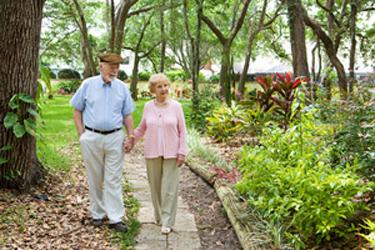EPA Science Matters Newsletter: Climate Change and the Health of Older Americans (Published April 2014)
EPA researchers are exploring the links between climate change and health effects for older Americans.

Climate change is affecting a growing population of at-risk older Americans. Studies by EPA researchers and others find that seniors aged 65 and older are more vulnerable to hot temperatures and extreme weather events—effects which will become more frequent as the climate changes.
In a recent paper, “Climate Change and Older Americans: State of the Science” (Environ Health Perspect 121:15–22. 2013), EPA researchers reviewed the current “state of the science” about the links between climate change and health effects impacting older Americans.
The paper explores connections between what is expected to be an increase in the population of older Americans living in places relatively more affected by climate change. “Life expectancy has increased at the same time that we see a huge bubble of baby boomers headed into retirement. These demographic changes are happening even as the effects of climate change are becoming more widely recognized,” explains EPA economist and lead author Janet Gamble.
To assess the vulnerability of older Americans to climate change, the research team performed an extensive literature search. From more than 400 citations identified, they selected nearly 100 papers to review that most closely addressed key terms describing characteristics of the older life stage; their vulnerability to climate-related impacts, and their overall health and well-being.
Older adults comprise 13% of the U.S. population today, but are expected to account for approximately 20% by 2040. They are also a diverse group, with differences in age, race/ethnicity, socioeconomic status, degree of community or family support, general health or pre-existing medical conditions, and disability. These differences ultimately determine the extent of older adults’ vulnerability to the impacts of climate change.
In addition, location matters. “Older adults are retiring in areas, such as Florida, that experience a higher rate of extreme weather events,” notes Gamble, adding that more that 50% of older adults reside in only nine states, with Florida, California, New York, Texas, and Pennsylvania accounting for the top five.
Regions with higher levels of older adults, such as the five states mentioned above, are likely to be particularly at risk to changing precipitation patterns, tropical storms, flooding, and the urban heat island effect, a term describing the warming of urban areas relative to their rural surroundings due to the prevalence of buildings, roads, and other dark, heat-absorbing surfaces.
The report finds that older adults living in poverty or on fixed incomes are likely to experience greater exposure to some climate-related impacts, especially the effects of heat waves or hurricanes. Poverty is a primary contributor to social vulnerability, as financial status affects their ability to respond quickly and effectively. Older adults living in poverty can be more vulnerable to property damage and loss due to lack of insurance, limited personal finances, and poor credit worthiness. In addition, older adults living in poverty may not have transportation to evacuate an area during an extreme weather event and may live in substandard housing, also increasing their risks.
The authors highlight a number of measures, called adaptations, that may address such vulnerabilities.
Such adaptations promote effective community responses to risks thought to be climate-related and may include: community support networks, subsidization of air conditioners, and community-based registries to help identify and reach those who require evacuation assistance. Similarly, planting trees or installing green roofs can reduce the urban heat island effect.
Identifying effective adaptation measures and outlining the best ways to implement them continue to be a challenge.
When asked about next steps, Gamble states, “I think there is more work to be done in assessing the vulnerability of at-risk populations. As a first step, we need to communicate the climate risks experienced by older adults to decision makers, public health and safety officials, and caregivers and advocates of aging populations. Also, in the near term, it may be possible to build on and adapt some of the response strategies developed for heat waves and hurricanes and apply them to the broader set of climate change impacts affecting older adults.”
By investigating the relationship between climate change stressors and vulnerability to at-risk life stages such as older Americans, EPA researchers are helping to inform communities and others so they can be better prepared to protect human health.
